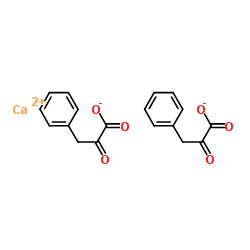Calcium phenylpyruvate

Calcium phenylpyruvate structure
|
Common Name | Calcium phenylpyruvate | ||
|---|---|---|---|---|
| CAS Number | 51828-93-4 | Molecular Weight | 366.378 | |
| Density | N/A | Boiling Point | N/A | |
| Molecular Formula | C18H14CaO6 | Melting Point | N/A | |
| MSDS | USA | Flash Point | N/A | |
|
Resolving phenylalanine metabolism sheds light on natural synthesis of penicillin G in Penicillium chrysogenum.
Eukaryotic Cell 11(2) , 238-49, (2012) The industrial production of penicillin G by Penicillium chrysogenum requires the supplementation of the growth medium with the side chain precursor phenylacetate. The growth of P. chrysogenum with phenylalanine as the sole nitrogen source resulted in the ext... |
|
|
Biotransformation of phenylpyruvic acid to phenyllactic acid by growing and resting cells of a Lactobacillus sp.
Biotechnol. Lett. 29(4) , 593-7, (2007) Phenyllactic acid (PLA) is a novel antimicrobial compound derived from phenylalanine (Phe). Lactobacillus sp. SK007, having high PLA-producing ability, was isolated from Chinese traditional pickles. When 6.1 mM phenylpyruvic acid (PPA) was used to replace Phe... |
|
|
Bioconversion of phenylpyruvate to phenyllactate: gene cloning, expression, and enzymatic characterization of D- and L1-lactate dehydrogenases from Lactobacillus plantarum SK002.
Appl. Biochem. Biotechnol. 162(1) , 242-51, (2010) Two DNA fragments containing the entire coding sequences of lactate dehydrogenase (LDH; ldhL1 and ldhD), whose enzymes have high activity for bioconversion of phenylpyruvate (PPA) to phenyllactate (PLA), were amplified from Lactobacillus plantarum SK002 using... |
|
|
Characterization of D-lactate dehydrogenase producing D-3-phenyllactic acid from Pediococcus pentosaceus.
Biosci. Biotechnol. Biochem. 76(4) , 853-5, (2012) D-Lactate dehydrogenase (D-LDH) from Pediococcus pentosaceus ATCC 25745 was found to produce D-3-phenyllactic acid from phenylpyruvate. The optimum pH and temperature for enzyme activity were pH 5.5 and 45 °C. The Michaelis-Menten constant (K(m)), turnover nu... |
|
|
Characterization of D-lactate dehydrogenase from Pediococcus acidilactici that converts phenylpyruvic acid into phenyllactic acid.
Biotechnol. Lett. 34(5) , 907-11, (2012) The gene coding for D-lactate dehydrogenase (D-LDH) from Pediococcus acidilactici DSM 20284 was cloned and expressed in E. coli. The recombinant enzyme was purified by nickel-affinity chromatography. It converted phenylpyruvic acid (PPA) to 3-phenyllactic aci... |
|
|
Production of natural antimicrobial compound D-phenyllactic acid using Leuconostoc mesenteroides ATCC 8293 whole cells involving highly active D-lactate dehydrogenase.
Lett. Appl. Microbiol. 59(4) , 404-11, (2014) Phenyllactic acid (PLA) is an antimicrobial compound naturally synthesized in various fermented foods and its D-form of PLA is known to be more active than the L-isomer. In this study, Leuconostoc mesenteroides ATCC 8293 cells, elaborating D-lactate dehydroge... |
|
|
Purification and partial characterization of Lactobacillus species SK007 lactate dehydrogenase (LDH) catalyzing phenylpyruvic acid (PPA) conversion into phenyllactic acid (PLA).
J. Agric. Food Chem. 56(7) , 2392-9, (2008) Phenyllactic acid (PLA) is a novel antimicrobial compound synthesized by lactic acid bacteria (LAB), and its production from phenylpyruvic acid (PPA) is an effective approach. In this work, a lactate dehydrogenase (LDH), which catalyzes the reduction of PPA t... |
|
|
3-Phenyllactic acid production by substrate feeding and pH-control in fed-batch fermentation of Lactobacillus sp. SK007.
Bioresour. Technol. 100(21) , 5226-9, (2009) 3-Phenyllactic acid (PLA), which is produced by some strains of lactic acid bacteria (LAB), is a known antimicrobial agent with a broad spectrum. Batch and fed-batch fermentation by the strain Lactobacillus sp. SK007 for PLA production have been reported. Wit... |
|
|
Study on urinary metabolic profile of phenylketonuria by micellar electrokinetic capillary chromatography with dual electrochemical detection--potential clinical application in fast diagnosis of phenylketonuria.
Anal. Chim. Acta 694(1-2) , 61-6, (2011) The urinary metabolic marker compounds, namely phenylpyruvic acid (PPA), 2-hydroxyphenylacetic acid (oOPAA), 4-hydroxyphenylacetic acid (pOPAA), phenyllactic acid (PLA) and phenylacetic acid (PAA) of phenylketonuric individuals were detected by a novel method... |
|
|
[Catalytic properties of enzymes from Erwinia carotovora involved in transamination of phenylpyruvate].
Prikl. Biokhim. Mikrobiol. 49(2) , 129-35, (2013) Km for L-phenylalanine, L-glutamic acid, L-aspartic acid, and the corresponding keto acids were calculated, as well as Vmax, was measured for the following pairs of substrates: L-phenylalanine-2-ketoglutarate, L-phenylalanine-oxaloacetate, L-glutamic acid-phe... |